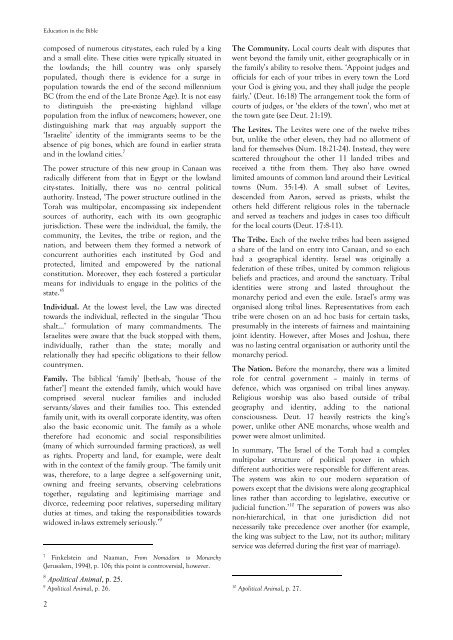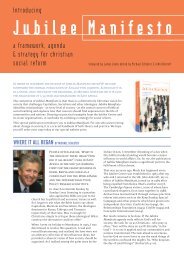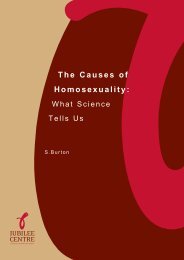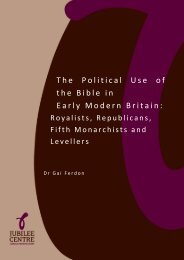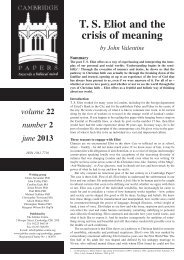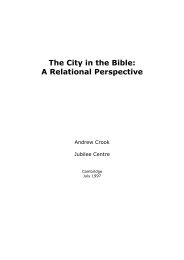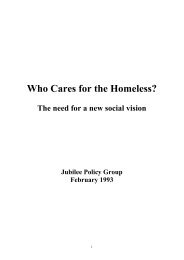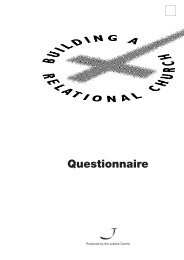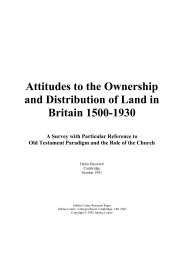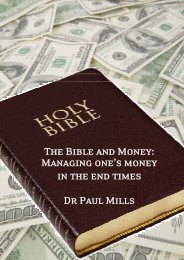Education in the Bible - Jubilee Centre
Education in the Bible - Jubilee Centre
Education in the Bible - Jubilee Centre
You also want an ePaper? Increase the reach of your titles
YUMPU automatically turns print PDFs into web optimized ePapers that Google loves.
<strong>Education</strong> <strong>in</strong> <strong>the</strong> <strong>Bible</strong><br />
composed of numerous city-states, each ruled by a k<strong>in</strong>g<br />
and a small elite. These cities were typically situated <strong>in</strong><br />
<strong>the</strong> lowlands; <strong>the</strong> hill country was only sparsely<br />
populated, though <strong>the</strong>re is evidence for a surge <strong>in</strong><br />
population towards <strong>the</strong> end of <strong>the</strong> second millennium<br />
BC (from <strong>the</strong> end of <strong>the</strong> Late Bronze Age). It is not easy<br />
to dist<strong>in</strong>guish <strong>the</strong> pre-exist<strong>in</strong>g highland village<br />
population from <strong>the</strong> <strong>in</strong>flux of newcomers; however, one<br />
dist<strong>in</strong>guish<strong>in</strong>g mark that may arguably support <strong>the</strong><br />
‘Israelite’ identity of <strong>the</strong> immigrants seems to be <strong>the</strong><br />
absence of pig bones, which are found <strong>in</strong> earlier strata<br />
and <strong>in</strong> <strong>the</strong> lowland cities. 7<br />
The power structure of this new group <strong>in</strong> Canaan was<br />
radically different from that <strong>in</strong> Egypt or <strong>the</strong> lowland<br />
city-states. Initially, <strong>the</strong>re was no central political<br />
authority. Instead, ‘The power structure outl<strong>in</strong>ed <strong>in</strong> <strong>the</strong><br />
Torah was multipolar, encompass<strong>in</strong>g six <strong>in</strong>dependent<br />
sources of authority, each with its own geographic<br />
jurisdiction. These were <strong>the</strong> <strong>in</strong>dividual, <strong>the</strong> family, <strong>the</strong><br />
community, <strong>the</strong> Levites, <strong>the</strong> tribe or region, and <strong>the</strong><br />
nation, and between <strong>the</strong>m <strong>the</strong>y formed a network of<br />
concurrent authorities each <strong>in</strong>stituted by God and<br />
protected, limited and empowered by <strong>the</strong> national<br />
constitution. Moreover, <strong>the</strong>y each fostered a particular<br />
means for <strong>in</strong>dividuals to engage <strong>in</strong> <strong>the</strong> politics of <strong>the</strong><br />
state.’ 8<br />
Individual. At <strong>the</strong> lowest level, <strong>the</strong> Law was directed<br />
towards <strong>the</strong> <strong>in</strong>dividual, reflected <strong>in</strong> <strong>the</strong> s<strong>in</strong>gular ‘Thou<br />
shalt…’ formulation of many commandments. The<br />
Israelites were aware that <strong>the</strong> buck stopped with <strong>the</strong>m,<br />
<strong>in</strong>dividually, ra<strong>the</strong>r than <strong>the</strong> state; morally and<br />
relationally <strong>the</strong>y had specific obligations to <strong>the</strong>ir fellow<br />
countrymen.<br />
Family. The biblical ‘family’ [beth-ab, ‘house of <strong>the</strong><br />
fa<strong>the</strong>r’] meant <strong>the</strong> extended family, which would have<br />
comprised several nuclear families and <strong>in</strong>cluded<br />
servants/slaves and <strong>the</strong>ir families too. This extended<br />
family unit, with its overall corporate identity, was often<br />
also <strong>the</strong> basic economic unit. The family as a whole<br />
<strong>the</strong>refore had economic and social responsibilities<br />
(many of which surrounded farm<strong>in</strong>g practices), as well<br />
as rights. Property and land, for example, were dealt<br />
with <strong>in</strong> <strong>the</strong> context of <strong>the</strong> family group. ‘The family unit<br />
was, <strong>the</strong>refore, to a large degree a self-govern<strong>in</strong>g unit,<br />
own<strong>in</strong>g and free<strong>in</strong>g servants, observ<strong>in</strong>g celebrations<br />
toge<strong>the</strong>r, regulat<strong>in</strong>g and legitimis<strong>in</strong>g marriage and<br />
divorce, redeem<strong>in</strong>g poor relatives, supersed<strong>in</strong>g military<br />
duties at times, and tak<strong>in</strong>g <strong>the</strong> responsibilities towards<br />
widowed <strong>in</strong>-laws extremely seriously.’ 9<br />
7<br />
F<strong>in</strong>kelste<strong>in</strong> and Naaman, From Nomadism to Monarchy<br />
(Jerusalem, 1994), p. 106; this po<strong>in</strong>t is controversial, however.<br />
8 Apolitical Animal, p. 25.<br />
9<br />
Apolitical Animal, p. 26.<br />
The Community. Local courts dealt with disputes that<br />
went beyond <strong>the</strong> family unit, ei<strong>the</strong>r geographically or <strong>in</strong><br />
<strong>the</strong> family’s ability to resolve <strong>the</strong>m. ‘Appo<strong>in</strong>t judges and<br />
officials for each of your tribes <strong>in</strong> every town <strong>the</strong> Lord<br />
your God is giv<strong>in</strong>g you, and <strong>the</strong>y shall judge <strong>the</strong> people<br />
fairly.’ (Deut. 16:18) The arrangement took <strong>the</strong> form of<br />
courts of judges, or ‘<strong>the</strong> elders of <strong>the</strong> town’, who met at<br />
<strong>the</strong> town gate (see Deut. 21:19).<br />
The Levites. The Levites were one of <strong>the</strong> twelve tribes<br />
but, unlike <strong>the</strong> o<strong>the</strong>r eleven, <strong>the</strong>y had no allotment of<br />
land for <strong>the</strong>mselves (Num. 18:21-24). Instead, <strong>the</strong>y were<br />
scattered throughout <strong>the</strong> o<strong>the</strong>r 11 landed tribes and<br />
received a ti<strong>the</strong> from <strong>the</strong>m. They also have owned<br />
limited amounts of common land around <strong>the</strong>ir Levitical<br />
towns (Num. 35:1-4). A small subset of Levites,<br />
descended from Aaron, served as priests, whilst <strong>the</strong><br />
o<strong>the</strong>rs held different religious roles <strong>in</strong> <strong>the</strong> tabernacle<br />
and served as teachers and judges <strong>in</strong> cases too difficult<br />
for <strong>the</strong> local courts (Deut. 17:8-11).<br />
The Tribe. Each of <strong>the</strong> twelve tribes had been assigned<br />
a share of <strong>the</strong> land on entry <strong>in</strong>to Canaan, and so each<br />
had a geographical identity. Israel was orig<strong>in</strong>ally a<br />
federation of <strong>the</strong>se tribes, united by common religious<br />
beliefs and practices, and around <strong>the</strong> sanctuary. Tribal<br />
identities were strong and lasted throughout <strong>the</strong><br />
monarchy period and even <strong>the</strong> exile. Israel’s army was<br />
organised along tribal l<strong>in</strong>es. Representatives from each<br />
tribe were chosen on an ad hoc basis for certa<strong>in</strong> tasks,<br />
presumably <strong>in</strong> <strong>the</strong> <strong>in</strong>terests of fairness and ma<strong>in</strong>ta<strong>in</strong><strong>in</strong>g<br />
jo<strong>in</strong>t identity. However, after Moses and Joshua, <strong>the</strong>re<br />
was no last<strong>in</strong>g central organisation or authority until <strong>the</strong><br />
monarchy period.<br />
The Nation. Before <strong>the</strong> monarchy, <strong>the</strong>re was a limited<br />
role for central government – ma<strong>in</strong>ly <strong>in</strong> terms of<br />
defence, which was organised on tribal l<strong>in</strong>es anyway.<br />
Religious worship was also based outside of tribal<br />
geography and identity, add<strong>in</strong>g to <strong>the</strong> national<br />
consciousness. Deut. 17 heavily restricts <strong>the</strong> k<strong>in</strong>g’s<br />
power, unlike o<strong>the</strong>r ANE monarchs, whose wealth and<br />
power were almost unlimited.<br />
In summary, ‘The Israel of <strong>the</strong> Torah had a complex<br />
multipolar structure of political power <strong>in</strong> which<br />
different authorities were responsible for different areas.<br />
The system was ak<strong>in</strong> to our modern separation of<br />
powers except that <strong>the</strong> divisions were along geographical<br />
l<strong>in</strong>es ra<strong>the</strong>r than accord<strong>in</strong>g to legislative, executive or<br />
judicial function.’ 10 The separation of powers was also<br />
non-hierarchical, <strong>in</strong> that one jurisdiction did not<br />
necessarily take precedence over ano<strong>the</strong>r (for example,<br />
<strong>the</strong> k<strong>in</strong>g was subject to <strong>the</strong> Law, not its author; military<br />
service was deferred dur<strong>in</strong>g <strong>the</strong> first year of marriage).<br />
10<br />
Apolitical Animal, p. 27.<br />
2


